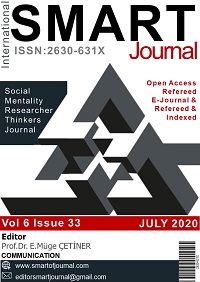Author :
Abstract
Kur’an tefsirinin doğru ve sağduyulu olarak yapılabilmesinin en önemli ilkelerinden birisi, sahip olunan peşin fikri destekleme amacıyla kutsal metni keyfi veya gelişigüzel yorumlarla bağlamından koparma çabalarından uzak durabilmektir. Çünkü bu tarz durumlarda, metnin ne dediğinden çok, ona neler söyletilebileceği hususu ön plana çıkmaktadır. Bu ise tarafsız ve objektif anlamayı engelleyen önemli bir etkendir. Metnin muhtevasıyla pek ilgisi olmamasına rağmen sahip olunan peşin fikir, çoğunlukla kökü ve kaynağı pek sağlam olmayan, hikâye kırıntılarıyla yoğrulmuş geleneksel ögelere dayanmaktadır. Yanısıra bahsedilen peşin fikirler, ulaştığı toplumlarda azımsanmayacak bir oranda kendisine gönül veren bireyleri de bir şekilde bulabilmektedir. Bu duruma verilebilecek en etkin örneklerden birisi de Davut Peygamber kıssasında anlatılan iki tarafın birbirinden şikâyetçi oldukları “na’ce/koyun” meselesidir. Bazı yorumlarda “na’ce” diye bahsedilen şeyin aslında kadın olduğu, Davut Peygamberin ordusunda bir nefer olan Ûriyâ isimli bir adamın nikâhlı karısını çıplak bir vaziyette görüp âşık olduğu ve mezkûr kadınla evlenebilmenin türlü türlü yollarına başvurduğu dile getirilmektedir. İşte bu çalışma, sözü edilen iddianın doğru olup-olmadığını ve bu çerçevede söylenen şeylerin bir peygambere yakışıp-yakışmadığını analitik bir şekilde ortaya koyup değerlendirmeyi amaç edinmektedir.
Keywords
Abstract
One of the most important principles of Qur'anic commentary being done correctly and without prejudice is to stay away from the efforts to detach the scriptures from the context with random or arbitrary interpretations in order to support a previously accepted idea. Because in such cases, the issue of what can be said to text comes to the fore rather than what the text says. This is an important factor that prevents neutral and objective understanding. The prejudiced idea, sometimes which has nothing to do with the content of the text, is mostly based on traditional elements, whose root and source are not very robust, kneaded with story fragments. In addition, the mentioned ideas can somehow find individuals who adopt itself to a considerable extent in the societies it reaches. One of the most effective examples that can be given to this situation is the issue of “na'ce / sheep” where the two sides described in the story of the Prophet David complain about each other. In some comments, it called as: What is expressed as "Na'ce" which mentioned in the Qur'an is actually a woman. The Prophet David saw the wife of Ûriya, a soldier in his army, in a naked position and then fell in love with her, then he resorted to all sorts of ways to marry the woman mentioned. This study aims to analyze and evaluate whether the claim in question is true and whether the things said within this framework suit for a prophet.
Keywords
- Buhârî, Ebu Abdillah Muhammed b. İsmail, el-Camiu’s-Sahîh, Çağrı Yayınları, İstanbul, 1981.
- Çelik, Ahmet, “Birey ve Toplumun Islahı Açısından Kur’an Kıssaları”, Atatürk Üniversitesi ilahiyat Fakültesi Dergisi, Erzurum 2004, Sayı: 22.
- Demirci, Sabri, Hucurat Suresi Işığında Sosyal Hayatın Ahlakî Prensipleri, Rağbet Yayınları, İstanbul 2015.
- Gündüz, Şinasi, “Kur’an Kıssalarının Kaynağı Eski Ahit mi? Yapı, Muhteva ve Kaynak Açısından Torah Kıssaları”, Ondokuz Mayıs Üniversitesi İFD, 1998, S. 10.
- İbn Atiyye, Ebu Muhammed Abdulhak b. Gâlib, el-Muharreru’l-Vecîz fî Tefsîri’l-Kitabi’l-Azîz, Tahkîk: Abdusselam Abduşşâfî Muhammed, Dâru’l-Kütübi’l-İlmiyye, Beyrut, 1422/2001.
- İbn Kesîr, Ebu’l-Fidâ’ İsmail b. Ömer, Tefsîru’l-Kur’âni’l-Azîm, Tahkîk: Muhammed Hüseyin Şemsuddin, Dâru’l-Kütübi’l-İlmiyye, Beyrut, 1419/1999.
- Kannûcî, Ebu’t-Tayyib Muhammed Sıddık Han, Fethu'l-Beyân fî Mekâsidi'l-Kur'ân, Mektebetü'l- Asriyye, Beyrut, 1412/1992.
- Karaman, Hayreddin; Mustafa Çağrıcı, İbrahim Kâfi Dönmez ve Sadrettin Gümüş, Kur’an Yolu Türkçe Meal ve Tefsir, DİB Yayınları, Ankara 2014.
- Kasımî, Muhammed Cemâluddîn b. Muhammed Saîd b. Kâsım, Meḥâsinü’t-Teʾvîl, Tahkîk: Muhammed Bâsil Uyûnussûd, Dâru’l-Kutubi’l-İlmiyye, Beyrut, 1418/1997.
- Kaya, Remzi, “Kur’an-ı Kerim Kıssaları ve Düşündürdükleri”, Uludağ Üniversitesi İFD, 2002, C. XI, S. 2.
- Keskin, Yusuf Ziya, “Elinden ve Dilinden Güvende Olmak”, https://dergi.diyanet.gov.tr / makaledetay. php?ID=29361, Erişim Tarihi: 03.04.2020
- Kurtubî, Ebu Abdillah Muhammed b. Ahmed, el-Câmi’ li Ahkâmi’l-Kur’ân, Tahkîk: Ahmed Berdûnî-İbrahim Etfiyyiş, Dâru’l-Kütübi’l-Mısriyye, Kahire, 1384/1964.
- Mâturîdî, Ebû Mansûr Muhammed b. Muhammed, Tefsîru’l-Mâturîdî=Te’vîlât-u Ehli’s-Sünne, Tahkîk: Mecdî Bâslûm, Dâru’l-Kütübi’l-İlmiyye, Beyrut 1426/2005.
- Mazharî, Muhammed Senâullâh, et-Tefsîru’l-Mazharî, Tahkîk: Gulâm Nebî Tûnusî, Mektebetu’r- Rüşdiyye, Pakistan, 1412/1992.
- Merağî, Ahmed b. Mustafa, Tefsiru’l-Merağî, Matbaat-u Mustafa el-Bâbî el-Halebî, Mısır 1365/1946.
- Mevdudî, Tarih Boyunca Tevhîd Mücadelesi ve Hz. Peygamber’in Hayatı, Çev. Ahmet Asrar, Pınar Yayınları, İstanbul 1992.
- Mukâtil b. Süleyman, Tefsîr-u Mûkatil b. Süleyman, Tahkîk: Abdullah Mahmûd Şahhâte, Dâr-u İhyâi’t-Turâs, Beyrût, 1423/2002.
- Müslim, Ebu Huseyn b. Haccac el-Kuşeyrî, el-Camiu’s-Sahîh, Tahkik: Abdulbaki, Muhammed Fuad, Mısır, 1347 (1955).
- Nesefî, Ebu’l-Berekât Abdullah b. Ahmed, Tefsîru’n-Nesefî=Medâriku’t-Tenzîl ve Hakaiku’t- Te’vîl, Tahkîk: Yusuf Ali Bedevî, Dâru'l-Kelimi’t-Tayyib, Beyrut, 1419/1998.
- Râzî, Fahruddin er-Râzî, Mefatîhu’l-Gayb=et-Tefsîru’l-Kebîr, Dar-u İhyâi’t-Türâsi’l-Arabî, et- Tebatu’s-Sâlise, Beyrut 1420/1999.
- Şevkânî, Muhammed b. Ali, Fethu’l-Kadîr, Dâr-u İbn Kesîr, Dımeşk, 1414/1993.
- Taberî, Muhammed İbn Cerîr, Câmiu’l-Beyân fî Tefsîri’l-Kur’ân, Tahkîk: Ahmed Muhammed Şakir, Muessesetu’r-Risâle, 1420/2000.
- Tirmizî, Ebu İsa Muhammed, Sünen, (Ofset Baskı), İstanbul, 1981.Turgay, “Kur’an Kıssaları”, Dicle Üniversitesi İFD, 2000, C. II.





